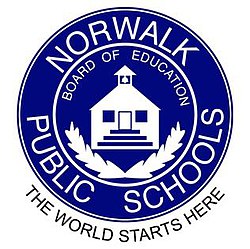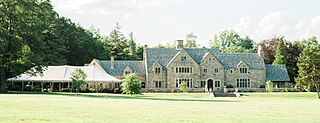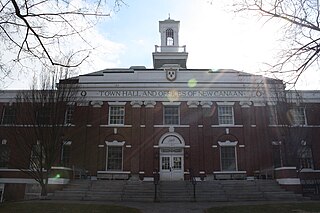
New Canaan is a town in Fairfield County, Connecticut, United States. The population was 20,622 according to the 2020 census. The town is part of the Western Connecticut Planning Region.

The No Child Left Behind Act of 2001 (NCLB) was a U.S. Act of Congress that reauthorized the Elementary and Secondary Education Act; it included Title I provisions applying to disadvantaged students. It supported standards-based education reform based on the premise that setting high standards and establishing measurable goals could improve individual outcomes in education. The Act required states to develop assessments in basic skills. To receive federal school funding, states had to give these assessments to all students at select grade levels.

Norwalk High School is a high school located in Norwalk, Connecticut, United States. It is the oldest high school in Norwalk, created in 1902, originally being housed in what is now Norwalk City Hall. The first graduating class for the current building was in 1975.

The Elementary and Secondary Education Act (ESEA) was passed by the 89th United States Congress and signed into law by President Lyndon B. Johnson on April 11, 1965. Part of Johnson's "War on Poverty", the act has been one of the most far-reaching pieces of federal legislation affecting education ever passed by the United States Congress, and was further emphasized and reinvented by its modern, revised No Child Left Behind Act.
Stamford High School is a high school, founded in 1873, in Stamford, Connecticut. It is one of three public high schools in the Stamford Public Schools district, along with Westhill High School and Academy of Information Technology and Engineering (AITE).

Brien McMahon High School (BMHS) is a secondary school located in Norwalk, Connecticut, United States. It is named after Brien McMahon, a former United States Senator from Norwalk. The school's mascot is a Senator and its colors are red, white, and blue. The school's first senior class graduated in 1962.
Adequate Yearly Progress (AYP) was a measurement defined by the United States federal No Child Left Behind Act that allowed the U.S. Department of Education to determine how every public school and school district in the country was performing academically according to results on standardized tests. As defined by National Council on Measurement in Education (NCME), AYP was "the amount of annual achievement growth to be expected by students in a particular school, district, or state in the U.S. federal accountability system, No Child Left Behind (NCLB)." AYP has been identified as one of the sources of controversy surrounding George W. Bush administration's Elementary and Secondary Education Act. Private schools were not required to make AYP.

Milwaukee Public Schools (MPS) is the largest school district in Wisconsin. As of the 2015–16 school year, MPS served 75,568 students in 154 schools and had 9,636 full-time equivalent (FTE) staff positions. The Milwaukee Public Schools system is one of the largest in the United States by enrollment. A publicly elected school board, the Milwaukee Board of School Directors, provides direction and oversight, with a superintendent heading the organization's administration.

Broad Run High School is a public secondary school in Ashburn, an unincorporated area in Loudoun County, Virginia, United States. Broad Run is part of the Loudoun County Public Schools system (LCPS). It was ranked as the #1 Best Public High School in Loudoun County and the #9 Best Public High School in Virginia by U.S. News in 2020.
Education in Stamford, Connecticut takes place in both public and private schools and college and university campuses.
There are an assortment of public, private, and parochial schools in Norwalk, Connecticut.
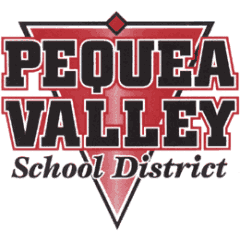
The Pequea Valley School District is a school district of 1,589 students educated in 4 schools by 127 teachers in Lancaster County, Pennsylvania in the United States. It is a member of Lancaster-Lebanon Intermediate Unit (IU) 13.
Pembroke High School, is a public secondary school located on 80 Learning Lane in Pembroke, Massachusetts, United States.
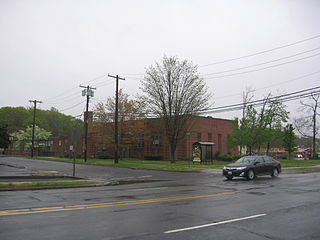
Richard C. Briggs High School was a secondary school located in Norwalk, Connecticut, USA. It opened in 1938 as a replacement for the Winnipauk School. Later it was turned into the secondary level Center for Vocational Arts but is now named after Dr. Richard C. Briggs, who was the superintendent of Norwalk schools from 1971 to 1980. Briggs High then became an alternative to the two traditional high schools. Its last principal was Marie Allen.

The Arkansas Department of Education (ADE) is a cabinet-level agency of the Arkansas state government overseeing public education for K-12, higher education institutions, and career and technical education.
The racial achievement gap in the United States refers to disparities in educational achievement between differing ethnic/racial groups. It manifests itself in a variety of ways: African-American and Hispanic students are more likely to receive lower grades, score lower on standardized tests, drop out of high school, and they are less likely to enter and complete college than whites, while whites score lower than Asian Americans.
Robert Bruce Duff is an American politician, currently serving as a member of the Connecticut State Senate, where he represents Norwalk and part of Darien in Connecticut's 25th District. He previously served as a member of the Connecticut House of Representatives, representing the 137th District. He is currently Majority Leader of the Connecticut Senate, and serves as chair of the Executive and Legislative Nominations Committee and vice chair of the Legislative Management Committee.

In the United States, elementary schools are the main point of delivery of primary education, for children between the ages of 4–11 and coming between pre-kindergarten and secondary education.

The Every Student Succeeds Act (ESSA) is a US law passed in December 2015 that governs the United States K–12 public education policy. The law replaced its predecessor, the No Child Left Behind Act (NCLB), and modified but did not eliminate provisions relating to the periodic standardized tests given to students. Like the No Child Left Behind Act, ESSA is a reauthorization of the 1965 Elementary and Secondary Education Act, which established the federal government's expanded role in public education.
